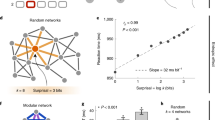Abstract
In the first part of the paper a general discussion of the transmission of information through neural chains is given in terms of the Shannon-Weaver theory. It is pointed out that with the all-or-none law a single chain of neurons connected in series transmits one bit of information per signal. A set ofN independent parallel chains transmitsN bits per signal. If, however, the chains are interconnected, the amount of information is reduced. At the same time, however, the degree of coordination of the final neuromuscular reaction is increased. A relation between the maximum possible speed of a reaction and its degree of coordination is derived, and possible applications to spoken language are suggested. A general quantitative discussion of the relation between amount of information and amount of knowledge which an individual may obtain when confronted with the external world is made and a possible connection with new trends in logical thinking is pointed out.
In the second part transmission of information through “social chains” is discussed under certain special assumptions. An expression for the “social channel noise” in terms of the length of the channel is derived. Finally an expression is given for the amount of information transmitted from one individual to another in a social group of uniform density as a function of the physical distance between the two individuals.
Similar content being viewed by others
Literature
Landahl, H. D. 1938. “A Contribution to the Mathematical Biophysics of Psychophysical Discrimination.”Psychometrika,3, 107–25.
Landau, H. G. 1950. “Note on the Effect of Imitation in Social Behavior.”Bull. Math. Biophysics,12, 221–36.
Jacobson, Edmund. 1930. “Electrical Measurements of Neuromuscular States during Mental Activities: III. Visual Imagination and Recollection.”Am. Jour. Physiol.,95, 694–702.
—. 1931. “Electrical Measurements of Neuromuscular States during Mental Activities: VII. Imagination, Recollection and Abstract Thinking Involving the Speech Musculature.”Ibid.,,97, 200–09.
Rashevsky, N. 1948.Mathematical Biophysics. Revised Edition. Chicago: University of Chicago Press.
— 1950.Mathematical Biology of Social Behavior. Chicago: University of Chicago Press.
Shannon, C. and W. Weaver. 1949.Mathematical Theory of Communication. Urbana (Ull.): University of Illinois Press.
Wiener, N. 1948.Cybernetics. New York: John Wiley & Sons, Inc.
Zipf, G. 1935.The Psychobiology of Language. Boston: Houghton-Mifflin.
Author information
Authors and Affiliations
Rights and permissions
About this article
Cite this article
Rashevsky, N. Some bio-sociological aspects of the mathematical theory of communication. Bulletin of Mathematical Biophysics 12, 359–378 (1950). https://doi.org/10.1007/BF02477907
Issue Date:
DOI: https://doi.org/10.1007/BF02477907




